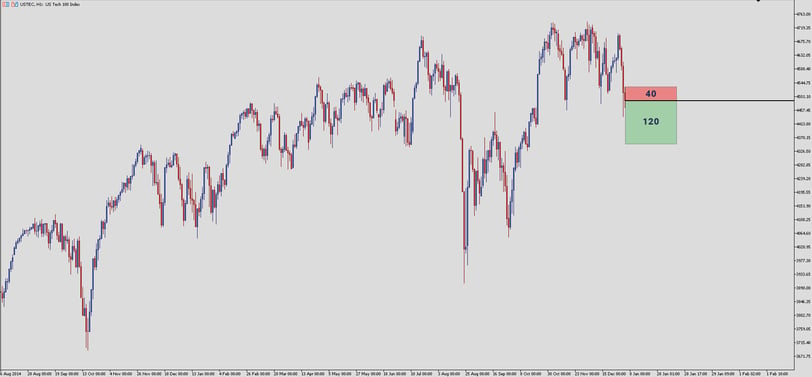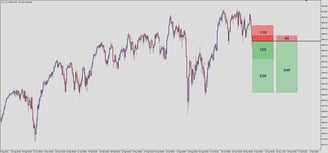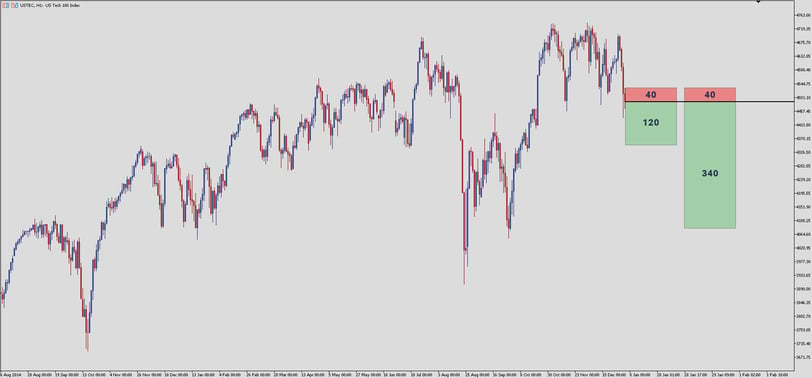Risk-Reward Ratio - Usage & Calculation
Risk-Reward is essential to understand and a perceptive aspect in market analysis and successful trading decisions throughout market volatilities and phases.
1/18/20256 min read


What is the Risk-Reward Ratio?
The risk-reward ratio (R:R) is among the most important metrics that traders use to evaluate the potential profitability of a trade against its potential loss. Essentially, this ratio quantifies the expected return on a trade in comparison to the level of risk undertaken. Calculated by dividing the potential profit by the potential loss, a high risk- reward ratio signifies a more favorable trade opportunity, whereas a low ratio suggests the opposite. But there is so much more to the risk-reward ratio as we will explore in this article.
Calculating the Risk-Reward Ratio
Calculating the Risk- Reward Ratio is not complicated. Assuming a trader is evaluating a potential short trade idea (screenshot below) with the current entry price 15387.8, a stop loss at price 15565.8, and take profit price 14854.6, getting to the risk- reward ratio is very straightforward:
First, you calculate the risk. The risk is the distance between the entry and the stop loss:
Risk = stop loss – entry = 15565.8 – 15387.8 = 178.0
Next, you calculate the potential reward of the trade. The reward is the distance between the entry and the take profit:
Reward = Entry – take profit = 15387.8 – 14854.6 = 533.2
To get the risk-reward ratio, you divide the reward by the risk we just calculated in the previous steps:
Risk-reward ratio = Reward / Risk = 533.2 / 178.0 = 2.99 = 3
Often, you will see the Risk-Reward Ratio then displayed as 3:1 which states that the trade has 3 times the reward, compared to the risk.
The calculation for a long (buy) trade follows the same logic. If you are using Tradingview, you can also just use their Long / Short Position tool to draw in your Risk-Reward Ratio automatically without doing any calculations.
What the Risk-Reward Ratio tells you!
Ideally, a trader measures the Risk-Reward Ratio before entering a trade to evaluate its profitability and to verify that the trade offers enough reward-potential. Let´s go over those two aspects to understand them better.
Risk-Reward Ratio & Trade Profitability
Continuing with our previous trade example and the 3:1 Risk-Reward Ratio, we can say that when taking the same trade, with the same premises, repeatedly, we can realize three losing trades and still end up break-even if we can win one out of every four trades:
Trade 1 – Loss: We lose 178 points (total loss 178)
Trade 2 – Loss: We lose 178 points (total loss 356)
Trade 3 – Loss: We lose 178 points (total loss 534)
Trade 4 – Win: We win 533.2 points
Total: +- 0 points
It is, therefore, very important to take trades that have a large enough Risk-Reward Ratio. It also highlights the fact that a trader does not have to win all (not even the majority) of their trades in order to make money long-term. If a trader can win two out of four trades with the same 3:1 Risk-Reward Ratio, they will net a profit at the end of the day.
Reward-Potential of Trades
Before entering a trade, the trader should analyze the chart situation and evaluate if the trade has enough reward-potential. If, for example, the price would have to go through a very important support or resistance level on its way to the take profit level, the reward potential of the trade might be limited.
Ideally, the trader identifies trading opportunities where the price does not have to travel through major support and resistance barriers in order to reach the target level. The more price “obstacles” are in the way from the entry to the potential target, the higher the chances that the price will bounce along the way and not reach the final target.
The Risk-Reward Ratio & Your Winrate
I have already hinted that there is a connection between the reward-to-risk ratio and the winrate of a trading system. With a 3:1 Risk-Reward Ratio, a trader can lose three out of four trades and still end up with a break-even result and not lose money. This would mean that for a 3:1 ratio, the minimum required winrate to reach a break-even point is 25%. We get the 25% winrate by dividing 1 by 4 (one winner for every four trades).
Naturally, the higher the Risk-Reward Ratio, the lower the required winrate to reach the break-even point. The table below shows the required winrate to reach the break-even point for different Risk-Reward Ratio sizes.




Understanding this natural relationship between stop loss and take profit distances can help traders make better decisions and improve their risk management. Many aspiring traders are not aware of how modifying their stop loss or take profit orders can impact their trading performance and completely change the outlook of their trades.
The Optional Risk-Reward Ratio
Inevitably, the question of the optimal risk-reward ratio then comes up. Unfortunately, there is no one-size-fits-all answer.
Many new traders gravitate towards a trend-following approach which typically requires a large risk-reward ratio which can be hard to pull off because, as we have learned, the higher the risk-reward ratio, the lower the winrate is usually going to be. Also, the time in the trade will increase. Both factors make it harder for inexperienced traders to realize good trades.
This could also explain why so many new traders are struggling with their trading performance. Staying in winning trades for an extended period is often challenging for new traders and many traders will, therefore, cut their winners short, reducing their profit potential and missing out on a lot of profits.
In the beginning, we recommend going for a lower Risk-Reward Ratio. This generally leads to a higher winrate and allows traders to build their confidence faster due to a higher winrate.
On the other hand, a closer stop loss means that it will be easier for the price to hit the stop loss. Even small price movements and low volatility levels can be enough to kick out traders from their trades when they utilize a closer stop loss order. The closer the stop loss, the lower the winrate because it is easier for the price to reach the stop loss.
In the screenshot below, the stop loss distance was halved and with it, the Risk-Reward Ratio doubles to 6:1. And although the Risk-Reward Ratio is significantly higher, the price will have a much easier time reaching the stop loss and ending the trade.-




THE DANGERS OF A RISK-REWARD RATIO
Now, many traders will assume that by aiming for a high risk-reward ratio, it should be easier to make money because you do not need a high winrate. And although this is true in theory, there are some caveats.
In order to achieve a high risk-reward ratio, a trader can either set their target levels very far away from the entry price to increase the reward of the trade, or use stop-loss orders that are very close to the entry price to reduce the risk part of the trade. Both would provide the trader with a higher risk-reward ratio. But what does this mean for the trade and why isn´t bigger also better when it comes to the risk-reward ratio?
A wide trade target means that the price action will require more time to reach its target level. Also, the farther away the target is from the entry, the lower the likelihood that the price will be able to make it all the way. The wider the target, the lower the chances of the price realizing the full winner. Wide targets, therefore, are harder to reach and typically result in a lower potential winrate.
The screenshot below illustrates this dynamic between the risk-reward ratio and the take profit. By doubling the take-profit distance, the risk-reward ratio doubles to 6:1. But taking a look at the new trade outlook it becomes apparent that the time in the trade will increase with it and the trade now has a higher chance of not making it all the way.
© 2025. All rights reserved.
You understand and acknowledge that there is a very high degree of risk involved in trading securities and, in particular, in trading forex, futures and options. Please ensure that you fully understand the risks involved. The site is providing educational content which will provide you with an indepth knowledge of the market. This site is in no way providing any investment, financial, tax, or legal advisory and do not purport to provide personalized investment, financial, tax, or legal advice in any form. None of the provided information does recommend the purchase of particular securities, nor does the provider promise or guarantee any particular results. The provider assumes no responsibility or liability for your trading and investment results, and you agree to hold the provider harmless for any such results or losses. It is up to you as a trader to make your own judgement using your own analysis.
